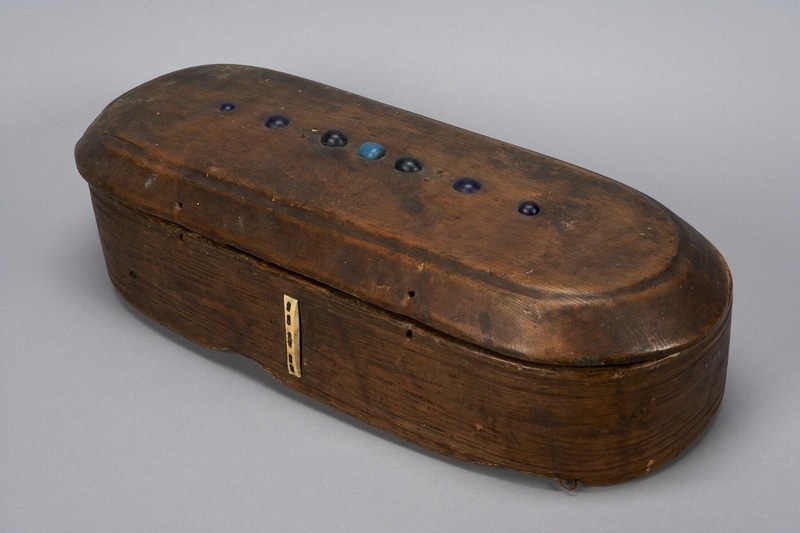Tool Box Item Number: Na1119 a-b from the MOA: University of British Columbia



Description
Brown bentwood oval box with lid (part b). Box is one piece, with bent sides with bevelled edges forming a flush side, sewn together with two parallel rows of baleen(?) and leather. Rectangular walrus tusk clasp between sewn rows with hooked appendage and six holes (or sets of holes), two form 'eyes' with hook as 'nose', attached through holes with leather strips. Two parallel grooves at top and bottom of sides. On opposite side is second walrus tusk rectangle with five sets of holes with leather strips attaching it to box. One top corner has wooden pegged (three) strip of wood; a longer damaged pegged (six) strip on end. Two holes on non-clasp side for attaching lid to box. Both are broken, remnants of one are on box, the other. Lid has a horizontal row on top of 7 beads with the central bead being light blue and the others being dark blue.
History Of Use
Used as a man's tool box. Often the box's inner surfaces are decorated, however, this one is plain.
Narrative
Similar to boxes from Kaialigamut (Fitzhugh and Kaplan, p.172).
Specific Techniques
Bentwood boxes and bowls are made from a slab of softwood, such as spruce, which is thinned with a crocked knife; the inner lower edge is grooved and the ends are beveled. The box is shaped by steam bending. The beveled edges are stitched together with spruce or willow root, baleen, or leather. The base is usually forced into the lower groove forming a tight fitting bottom. On lid; bottom is attached with tied leather strips at corners and below clasp. The strip below clasp and at 2 corners are broken or missing. Bottom of bottom is flat with sloping sides. Lid rests on top of box with sloping sides and flat top.
Item History
- Made in Alaska, USA
- Owned by Marianne Koerner and Walter C. Koerner before January 8, 1981
- Received from Marianne Koerner (Donor) and Walter C. Koerner (Donor) on January 8, 1981
What
- Name
- Tool Box
- Identification Number
- Na1119 a-b
- Type of Item
- box
- Material
- leather skin, walrus tusk, glass, wood and baleen ?
- Manufacturing Technique
- carved, steamed, bent, inlaid, tied, pegged, sewn and drilled
- Overall
- height 15.5 cm, width 54.0 cm, depth 20.5 cm
- Part A
- height 11.0 cm, width 54.0 cm, depth 20.5 cm
- Part B
- height 4.5 cm, width 54.0 cm, depth 20.5 cm
Who
- Culture
- Inuit
- Previous Owner
- Marianne Koerner and Walter C. Koerner
- Received from
- Marianne Koerner (Donor) and Walter C. Koerner (Donor)
Where
- Holding Institution
- MOA: University of British Columbia
- Made in
- Alaska, USA
When
- Ownership Date
- before January 8, 1981
- Acquisition Date
- on January 8, 1981
Other
- Condition
- fair
- Current Location
- Case 48
- Accession Number
- 0697/0040 a-b